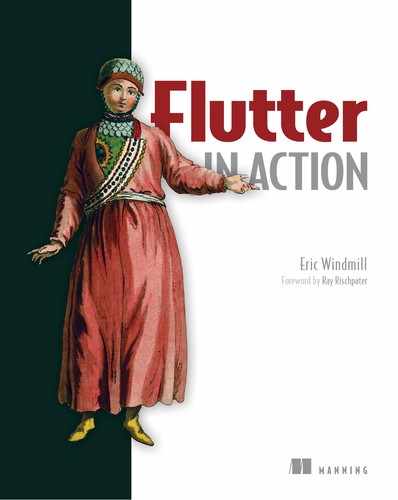Table of Contents
1.1. Why does Flutter use Dart?
1.4. Who should be using Flutter?
1.4.1. Teams, project leads, and CTOs
1.6. Other mobile development options
1.7. The immediate benefits of Flutter
1.7.3. Write once, test once, deploy everywhere
1.8. Future benefits of Flutter: Web apps and desktop apps
1.9. A brief intro to how Flutter works
1.10. Flutter rendering: Under the hood
Chapter 2. A brief intro to Dart
2.2. Common programming concepts in Dart
2.2.1. Intro to Dart’s type system
2.4.1. Anatomy of a Dart function
2.4.3. Default parameter values
2.5. Object-oriented programming (in Dart)
Chapter 3. Breaking into Flutter
3.1.1. Flutter project structure
3.1.2. Anatomy of a Flutter app
3.1.3. Again, everything is a widget
3.2. Widgets: The widget tree, widget types, and the State object
3.4. Enhancing the counter app with the most important widgets
3.5. Favor composition in Flutter (over inheritance)
3.6. Intro to layout in Flutter
3.6.2. Layout constraints in Flutter
3.6.4. RenderObject and constraints
3.6.5. RenderBoxes and layout errors
3.7.2. Exploring the element tree with an example
2. Flutter user interaction, styles, and animations
Chapter 4. Flutter UI: Important widgets, themes, and layout
4.1. Setting up and configuring a Flutter app
4.2. Structural widgets and more configuration
4.3. Styling and themes in Flutter
4.4. Common layout and UI widgets
Chapter 5. User interaction: Forms and gestures
5.1. User interaction and gestures
5.1.1. The GestureDetector widget
5.3.1. The TextFormField widget
5.4. Form UI and working with focus nodes
5.5. Managing form state with form methods
Chapter 6. Pushing pixels: Flutter animations and using the canvas
6.1. Introducing Flutter animations
6.1.6. Implementing the animation controller and tween for the background
6.2. CustomPainter and the canvas
6.2.1. The shapes used to make up the clouds
6.3. Staggered animations, TweenSequence, and built-in animations
6.3.1. Creating a custom animation state class
6.3.2. Built-in animation widgets: SlideTransition
3. State management and asynchronous Dart
Chapter 7. Flutter routing in depth
7.2. Declarative routing and named routes
7.2.2. Navigating to named routes
7.2.3. MaterialDrawer widget and the full menu
7.2.4. Menu items and the appropriate widgets: ListView and ListItems
7.2.5. NavigatorObserver: Highlighting the active route with RouteAware
Chapter 8. Flutter state management
8.1. Deep dive into StatefulWidgets
8.2. Pure Flutter state management: The InheritedWidget
8.2.1. Creating a Central Store wth an InheritedWidget/StatefulWidget team
8.2.2. The inheritFromWidgetOfExactType and of methods
8.3. Blocs: Business Logic Components
8.3.2. Implementing the bloc architecture
Chapter 9. Async Dart and Flutter and infinite scrolling
9.1.2. The async/await keywords
9.2. Sinks and streams (and StreamControllers)
9.4. Async Flutter: StreamBuilder
9.5. Infinite and custom scrollable widgets
9.5.1. CustomScrollView and slivers
Chapter 10. Working with data: HTTP, Firestore, and JSON
10.2.2. Auto-generated JSON serialization
10.3. Working with Firebase in Flutter
10.3.2. Create a Firestore project
Chapter 11. Testing Flutter apps
11.1.2. Using mockito to test methods that need external dependencies
A.2. Installation: Flutter SDK
B.1. Hosted packages and versioning with Pub
B.2. Using packages on your machine or from GitHub
C.2. How is layout handled in Flutter? Is there a flexbox equivalent?
C.3. What about using an absolute position?
C.4. What about the basics: Borders, padding, margin, and color?
D.1. What’s the equivalent of UIView in Flutter?
D.2. What’s the paradigm or mental model difference?
D.3. Can I build an app that uses iOS design patterns?
D.4. How to I make complex layouts like UITableView?
D.5. What’s similar to Storyboard?
D.6. How do you draw to the screen?
D.7. How do I add dependencies (like Cocoa Pods)?
E. Flutter for Android developers
E.1. What’s the equivalent of a view in Flutter?
E.2. What’s the paradigm or mental model difference?
E.3. Where’s the XML layout file?
E.4. How do I draw to the screen?
E.5. What’s the equivalent of an intent in Flutter?
E.6. What’s the equivalent of runOnUiThread() in Flutter?
E.7. What’s the equivalent of a Gradle file? How do I add dependencies?
E.8. What’s the equivalent of a LinearLayout? What about ScrollView?
